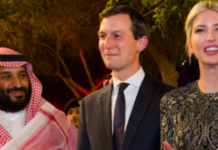Have you ever heard the saying, “Loose lips sink ships”?
Donald Trump has a lot of bad qualities.
But loquaciousness might be among his worst.
A president must possess an enormous degree of restraint with sensitive information.
One slip up can send the stock market reeling–or worse.
So, when a president stands before the nation to announce a secret U.S. military operation intended to eliminate a key ISIS figure has been successful, we should assume that president is not only being honest, but revealing solely appropriate information the American public–and the world–require lest he compromise pending operations and intelligence information.
Nothing more.
That’s what a president would do.
Not Donald Trump.
Trump’s Sunday morning announcement of ISIS leader Abu Bakr al-Baghdadi’s death was a big deal.
Yet Trump’s inability to stick to the script revealed sensitive information that could risk imperiling future raids, special operations, and intelligence.
During his 48-minute speech (in which he characterized watching the raid “as though you were watching a movie“) replete with spin and hyperbole, Trump described how the Army Delta Force chased al-Baghdadi through a tunnel network, culminating in his immolating himself and his three children with a suicide vest.
But then it got weird.
Retired Army lieutenant general and the former senior special operations Middle East commander during the incipient anti-ISIS campaign, Michael Nagata, criticized the president’s account:
“I always get a little bit nervous when people without knowledge of operations start describing operations. It’s a good story, and I can understand the impulse to tell a good story. Telling it can have positive benefits. But the benefits are unpredictable and marginal, whereas the harm could be more substantial.”
A former senior military officer in the Middle East region, speaking anonymously, added:
“I’m surprised that he [Trump] went into that level of granularity.”
Although not including specific information about how the U.S. located al-Baghdadi, Trump conveyed the highly sensitive nature of signals intelligence, the remote monitoring of enemy communications, stating:
“These people are very smart, they’re not into cell phones anymore. They’re not— they’re very technically brilliant. You know, they use the internet better than almost anybody in the world, perhaps other than Donald Trump. But they use the internet incredibly well.”
Michael Nagata wondered:
“Why mention it? It could contribute to a reverse engineering of our intelligence methods by the adversary, and if there’s any possibility of that, why do it?”
Trump also detailed the layout of al-Baghdadi’s compound:
“The tunnels were dead end for the most part. There was one we think that wasn’t but we had that covered too.”
That’s sensitive information, according to another former special operations commander, also speaking anonymously.
He added:
“The enemy knows to some degree that we have technology that can detect that. But they don’t know how it’s done or how good we are at, and we don’t want them to.”
Former Army officer Eric Robinson said:
“This is something the president should not have said about the target development. It’s reckless. But it’s not as bad as hanging the satellite image of the Iranian space launch site two months ago. That was bad.”
Trump didn’t stop there, though.
He described how the eight helicopters the commandos used “blew holes into the side of the building, not wanting to go through the main door because that was booby-trapped.”
Eric Robinson commented:
“Aircraft counts and means of conducting a breach are [tactics, techniques, and procedures] that special operations forces have developed and learned the hard way. That wasn’t helpful to talk about.”
One of the former special operations commanders added:
“The enemy sees the scene after, they’re on the ground, they see the breaching holes in building—but come on, let them figure it out on their own, don’t tell them. There’s no reason to reveal that. You’re giving them another way to think about how long forces on the ground are vulnerable. Timing on an objective is something where you never want the bad guys to know what your procedure was or how long it took.”
Trump admitted American commandos gathered intelligence, including information on “ISIS’ origins, future plans, things that we very much want.”
The aforementioned former special operations commander said:
“They don’t need to know what we took out of there.”
What irked former military officials most, though, was when Trump talked about helicopters that “took an identical route” back to a safe zone.
The anonymous former special operations commander exclaimed:
“I don’t know why the f— he would say that, honestly. If we’re doing the same approaches and egresses, that can get helicopters shot down. It’s happened in Afghanistan.”
Michael Nagata commented:
“That’s the most worrisome. The force is vulnerable throughout the operation, but arrival and departure by helicopter are very dangerous. For me, the idea that anyone would talk publicly about how we did the most dangerous part of the operation—the risks far outweigh the storytelling value.”
Moreover, Trump is angering some members of the military community after declassifying a photo and breed of the dog wounded in the raid.
We have declassified a picture of the wonderful dog (name not declassified) that did such a GREAT JOB in capturing and killing the Leader of ISIS, Abu Bakr al-Baghdadi! pic.twitter.com/PDMx9nZWvw
— Donald J. Trump (@realDonaldTrump) October 28, 2019
At least he kept the dog’s name secret.
One former senior White House official said:
“We agonized over what we would put in his briefings because who knows if and when he’s going to say something about it. He has no filter. But also if he knows something, and he thinks it’s going to be good to say or make him appear smarter or stronger, he’ll just blurt it out.”
Trump was so enamored with the “movie” of the raid, the Pentagon released declassified video and images showing US forces taking small arms fire as their helicopters zeroed in on the compound.
Perhaps the public version will be edited to include sound, because the version the president saw does not despite his assertion Abu Bakr al-Baghdadi was “whimpering, crying and screaming all the way.”
US Central Command, Gen. Frank McKenzie, told reporters he could not confirm that.
Intelligence and military officials told the New York Times the footage connected to the White House situation room broadcasted overhead surveillance shots of the dark compound with heat signatures identifying individuals featured, like U.S. forces.
That footage would not have been able to extend into the tunnel where al-Baghdadi was supposedly “whimpering, crying and screaming,” nor include audio of it.
Defense Secretary Mark Esper refused to corroborate the president’s story while appearing on ABC’s This Week, saying:
“I don’t have those details. The president probably had the opportunity to talk to commanders on the ground.”
What can we expect from a reality TV star?
This is the alternative reality in which Donald Trump is forcing us all to live.
Image credit: commons.wikimedia.org





